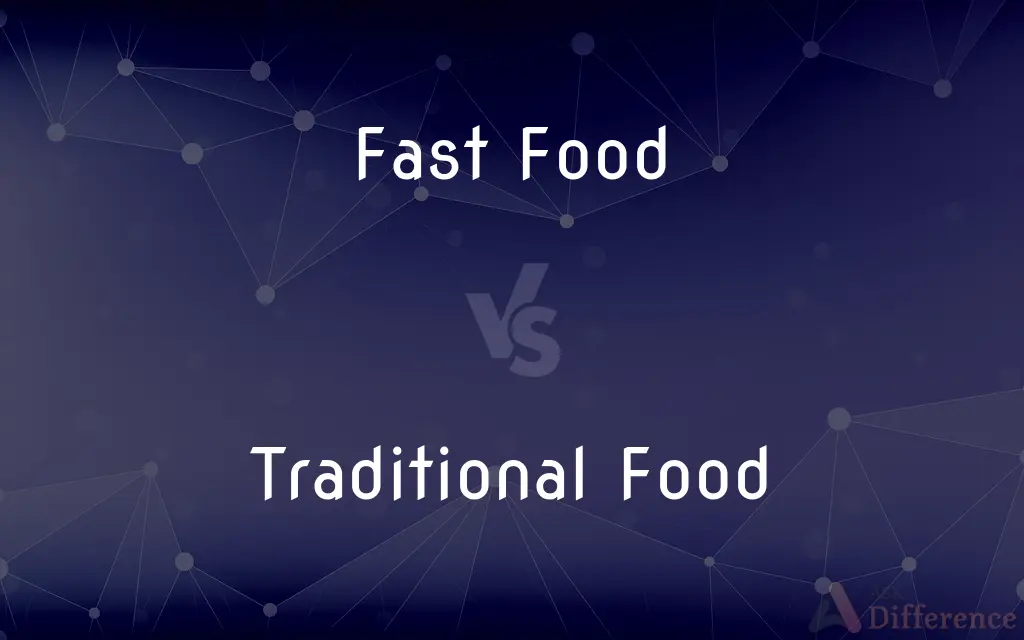Fast Food vs. Traditional Food — What's the Difference?
By Tayyaba Rehman — Published on November 18, 2023
Fast Food is quick to prepare and serve, focusing on convenience. Traditional Food, on the other hand, emphasizes cultural and historical dishes, often requiring longer preparation times.

Difference Between Fast Food and Traditional Food
Table of Contents
ADVERTISEMENT
Key Differences
Fast Food is designed for speed and convenience. It typically involves pre-cooked or easily cooked ingredients that can be prepared and served within a few minutes. Traditional Food, however, is rooted in a region's history, customs, and traditions, with dishes often passed down through generations.
Fast Food often involves a standardized menu and uniform taste across various outlets of a chain. This ensures consistency and quick recognition by consumers. Traditional Food, conversely, might vary even within a single region, adapting to local flavors, ingredients, and individual family recipes.
Fast Food typically prioritizes convenience and speed. This often leads to the use of preservatives, additives, and other measures to keep food fresh for longer periods. Traditional Food, meanwhile, tends to emphasize fresh, local ingredients, prepared without the extensive use of artificial additives.
The consumption settings also differ. Fast Food is often consumed on the go, in cars, or at quick-service restaurants. Traditional Food is more commonly enjoyed at home, during family gatherings, or at restaurants that aim to offer a more authentic dining experience.
The cultural implications vary too. Fast Food symbolizes the modern, fast-paced lifestyle, catering to urban populations looking for quick meals. Traditional Food, on the other hand, carries a heritage, a story, and a connection to a community's past, emphasizing cultural identity and history.
ADVERTISEMENT
Comparison Chart
Preparation Time
Quick, often within minutes
Longer, sometimes hours or days
Standardization
Standardized menu across outlets
Varies based on region or family recipes
Ingredients
Often includes preservatives and additives
Uses fresh, local ingredients
Consumption Setting
On the go, quick-service restaurants
At home, family gatherings, authentic diners
Cultural Implication
Modern, fast-paced lifestyle
Heritage, cultural identity, historical roots
Compare with Definitions
Fast Food
Ready-made meals prepared and served quickly.
I grabbed some Fast Food on my way home from work.
Traditional Food
Dishes passed down through generations.
My grandmother's pie is a much-loved Traditional Food in our family.
Fast Food
Convenient food often characterized by its speed of delivery.
Fast Food is a staple for many busy urbanites.
Traditional Food
Food items made using age-old recipes and methods.
The village is known for its Traditional Food made from local produce.
Fast Food
Food items designed for on-the-go consumption.
I prefer Fast Food when I'm in a rush.
Traditional Food
Meals rooted in a region's history and culture.
Sushi is a Traditional Food of Japan.
Fast Food
A quick-service meal often from chain restaurants.
The city's main street is lined with Fast Food joints.
Traditional Food
Dishes that emphasize authenticity over modern adaptations.
While traveling, I always look for places serving Traditional Food.
Fast Food
Standardized meals with consistent taste across outlets.
The Fast Food burger tasted the same in New York as it did in LA.
Traditional Food
Culinary items symbolizing cultural identity.
The festival is incomplete without its array of Traditional Food.
Fast Food
Inexpensive food, such as hamburgers and fried chicken, prepared and served quickly.
Fast Food
Of, pertaining to, or serving fast food.
Common Curiosities
Is Fast Food more standardized than Traditional Food?
Yes, Fast Food often has a consistent taste across outlets, while Traditional Food can vary based on local recipes.
Can Fast Food be considered a Traditional Food in some cultures?
Over time, some Fast Foods might gain cultural significance, but they are primarily distinguished by their quick preparation.
Why is Fast Food popular in urban areas?
Fast Food caters to the fast-paced lifestyle of urban populations, offering convenience and speed.
What is Fast Food?
Fast Food is ready-made food prepared and served quickly, emphasizing convenience.
How does Fast Food differ from Traditional Food in preparation?
Fast Food is made quickly, often using pre-cooked ingredients, while Traditional Food may require longer preparation times.
Can Traditional Food adapt to modern tastes?
Yes, while Traditional Food is rooted in history, it can evolve and incorporate modern influences.
How has globalization impacted Fast Food and Traditional Food?
Globalization has popularized Fast Food worldwide and has also led to the fusion and adaptation of Traditional Foods across cultures.
Are there environmental concerns with Fast Food?
Yes, Fast Food industries can contribute to waste, especially with packaging, and might rely on unsustainable food production methods.
Do Traditional Foods have cultural significance?
Yes, Traditional Food often carries cultural, historical, and familial significance.
Is Fast Food less healthy than Traditional Food?
Not necessarily, but Fast Food often contains preservatives and additives, while Traditional Food tends to use fresh ingredients.
How does the dining experience differ?
Fast Food is often for on-the-go or quick dining, while Traditional Food is enjoyed in a more relaxed setting.
Can Traditional Food be served quickly like Fast Food?
While some Traditional Foods might be served quickly, they typically emphasize authentic preparation methods, which can take longer.
Is every region's home-cooked meal considered Traditional Food?
Typically, yes. Home-cooked meals rooted in a region's history and customs can be classified as Traditional Food.
Is Fast Food always from chain restaurants?
No, while many are chains, there are independent Fast Food outlets as well.
How has technology impacted Fast Food?
Technology has streamlined Fast Food services, enabling online orders, digital payments, and faster service.
Share Your Discovery

Previous Comparison
Noodles vs. Pasta
Next Comparison
3G vs. CDMAAuthor Spotlight
Written by
Tayyaba RehmanTayyaba Rehman is a distinguished writer, currently serving as a primary contributor to askdifference.com. As a researcher in semantics and etymology, Tayyaba's passion for the complexity of languages and their distinctions has found a perfect home on the platform. Tayyaba delves into the intricacies of language, distinguishing between commonly confused words and phrases, thereby providing clarity for readers worldwide.
















































